Su-27TM Flanker-T
Tanruil's Flying Ballerina
-Lore-

In 1985, the Pulchriturian Royal Air Force (PRAF) aimed to explore options to upgrade their successful air superiority fighter & interceptor; the F-15 Eagle. With international rivalries growing slowly but noticeably since the end of the Gruneheimian Conflict of 1954, Gaia's previous major conflict, the PRAF predicted the need for military aircraft capable of using shorter, bombed-out runways, or shorter & rougher takeoff spaces in the prediction that airstrips would likely be targeted in a first strike. Pulchriturian interceptors were primarily in trouble, this being their F-15 Eagles, an aircraft unsuitable for short takeoff and landing distances.
So the PRAF came to the Pulchriturian Technical Institute (PTI)--a joint organization consisting of Pulchrituria's most successful engineering corporations which included the manufacturer of the Eagle--and commissioned for a special F-15D with modified avionics to allow the collection of flight data, a more-powerful pair of engines derived from the F-16 lightweight fighters, variable engine nozzles that allow for thrust vectoring up to 20 degrees in all directions, and front canards attached to the front-most sides of the fuselage just next to the variable intakes--sizable canards taken from the production line of the Pulchriturian Royal Navy's (PRN) F/A-18 Hornets.
The aircraft rolled off the assembly line by 1986 and was named the F-15 F-SCD (First-Strike Condition Demonstrator).
Years of research went by, with the PTI and PRAF finding takeoff distances reduced by 10-15% depending on conditions & weapon loads, landing/stopping distances reduced by up to 30%, and controlled flight at up to 85 degrees of AoA.
Within this period of research and testing, the aircraft's maneuverability in flight was tested and adjusted over time, proving to be more maneuverable in a dogfight than the production F-15's due to its greatly-improved maneuverability--provided by 3-D thrust vectoring & canards and an incredible thrust-to-weight ratio--and more potent in BVR fights due to its greater acceleration and turning capability. Improvements in flight performance only improved further as the PTI began their research in intelligent flight control systems, using the FCS of the PRAF F-16 as a baseline and applying it to the F-15 F-SCD
Due to this projected improvement in performance over the standard Eagles, the PRAF greenlit and commissioned a production variant of the F-15 F-SCD to be in production by 1996, equipped with the F-15E's radar, avionics--including software which allow for air-to-ground weapon compatibility--and compatibility for the CFT of the standard Eagles to allow additional fuel capacity for less drag than external tanks.
The aircraft came to be named the F-15S "Agile Eagle", seeing service for the first time in 2002, flown by PRAF 10 pilots & their trusted WSO's over Tanruil during the Three-Week War, wearing Tanruilian Air Defense Force F-15C liveries to assist Tanruil in their air and ground campaign against Natsik invaders.
The war ended with the Agile Eagles scoring a 31:0 kill ratio, with the PRAF flight crews left unnamed and the 10 disguised Agile Eagles being handed to the Tanruilians as a token of allegiance. (edited)
[5:51 PM]
-Description-

With the boring part over--meet the Su-27TM Flanker-T, a fictional, supermaneuverable, multirole, twin-engined fighter based on the Su-27S, with upgrades making it similar to the Su-35S. New 3-D thrust vectoring nozzles allow for additional nose authority and post-stall maneuverability & control, and more aggressive takeoffs made possible for rushed sorties. A drogue chute makes aggressive landings quite possible too.
It wears a paintjob akin to the colors of the blue VVS livery on Ukrainian Flankers. Consider it a little tribute to a country currently defending its sovereignty, just like Tanruil did during the Three Week War.
-Loadouts-
Current Loadout- Air Superiority - 4x R-73, 8x R-77
Alt. Loadout 1 - Anti-ship - 4x R-73, 4x R-77, 2x Kh-31A
Alt. Loadout 2 - Strike - 4x R-73. 4x R-77, 4x KAB-500Kr
Alt. Loadout 3 - Clean
-Controls-
Normal [Throttle]/[Pitch]/[Roll]/[Yaw]/[LandingGear]
- [Throttle = 85% to 90%] Military Power
- [Throttle = 90% to 100%] Afterburner
[VTOL] Elevator Trim (Inverted)
- [VTOL = -100%] Overpitch
[Trim = -100% to 0%] Flaps (Inverted)
[FireGuns] Fire 1x 30mm GSh-30-1
[AG1] Lights
[AG2] Reduced-Stability Mode (RSM)
[AG3] Drogue Chute
[AG8] Master Arm
Hardpoint Activation Groups
[AG4] Wingtip Hardpoint/Wing Hardpoint 1 R-73 Manual Release
[AG5] Wing Hardpoint 2/3 R-77 Manual Release
[AG6] Fuselage Hardpoint 1 R-77 Manual Release
[AG7] Fuselage Center Hardpoint 1/2 R-77 Manual Release
-Author’s Notes-
- Fuel and gun ammo is unlimited.
- On takeoff from runways, I recommend 100% flaps with 60% trim. Get to around 240 km/h and give slight taps for the pitch to avoid tail striking. (For keyboard users)
- On landing, use the trim to achieve your glide slope and adjust using pitch. (For keyboard users)
- To perform a cobra maneuver, slow to 680 km/h, throttle to military power/afterburner (if you haven’t already), activate RSM, and pitch up. Simply bring the nose back down and release pitch to level out.
- To perform a kulbit maneuver, slow to 680 km/h, activate afterburner & RSM, and pitch up. You must be level and around the height of your kulbit or you will lose yaw stability. As you reach 225 degrees of rotation during the kulbit (45 degrees from nose facing the rear), release pitch and let the fly-by-wire stabilize the plane to level out.
- To perform a falling leaf maneuver, slow to 600 km/h, activate RSM, and roll & pitch up simultaneously to initiate the spin. Then, once the spin initiates, you can use yaw to control spin speed and the pitch to control the nose for more or less angle. To recover, release yaw and pitch up to generate lift and speed until you begin flying straight again. Or deactivate RSM and let the plane guide itself back to stability. Warning: You may be significantly lower in altitude than where you started.
-Credits-
- @ReinMcdeer - for the original Su-27S, and the Su-27S seen in the Lore and Description screenshots.
Specifications
General Characteristics
- Predecessor Su-27S Flanker-B V2.6
- Created On Windows
- Wingspan 46.6ft (14.2m)
- Length 71.7ft (21.9m)
- Height 19.6ft (6.0m)
- Empty Weight 39,960lbs (18,125kg)
- Loaded Weight 49,407lbs (22,410kg)
Performance
- Power/Weight Ratio 1.387
- Wing Loading 65.9lbs/ft2 (321.7kg/m2)
- Wing Area 749.8ft2 (69.7m2)
- Drag Points 2167
Parts
- Number of Parts 438
- Control Surfaces 6
- Performance Cost 1,948

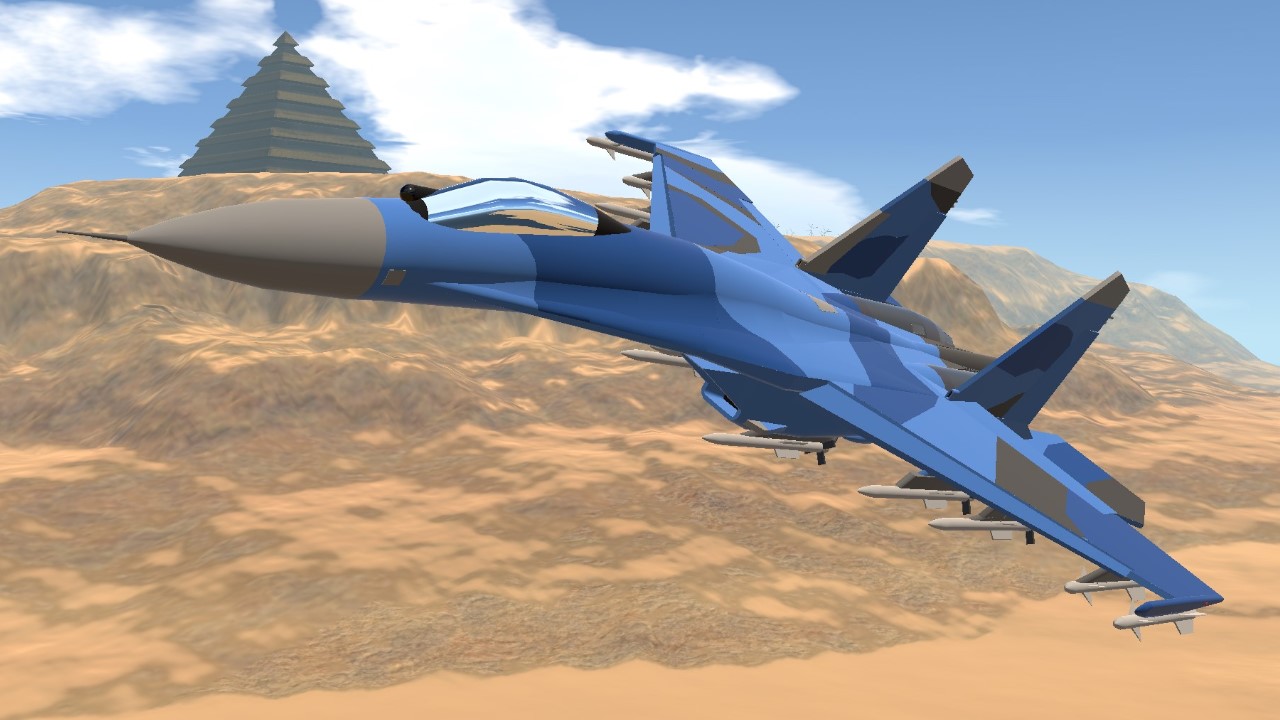
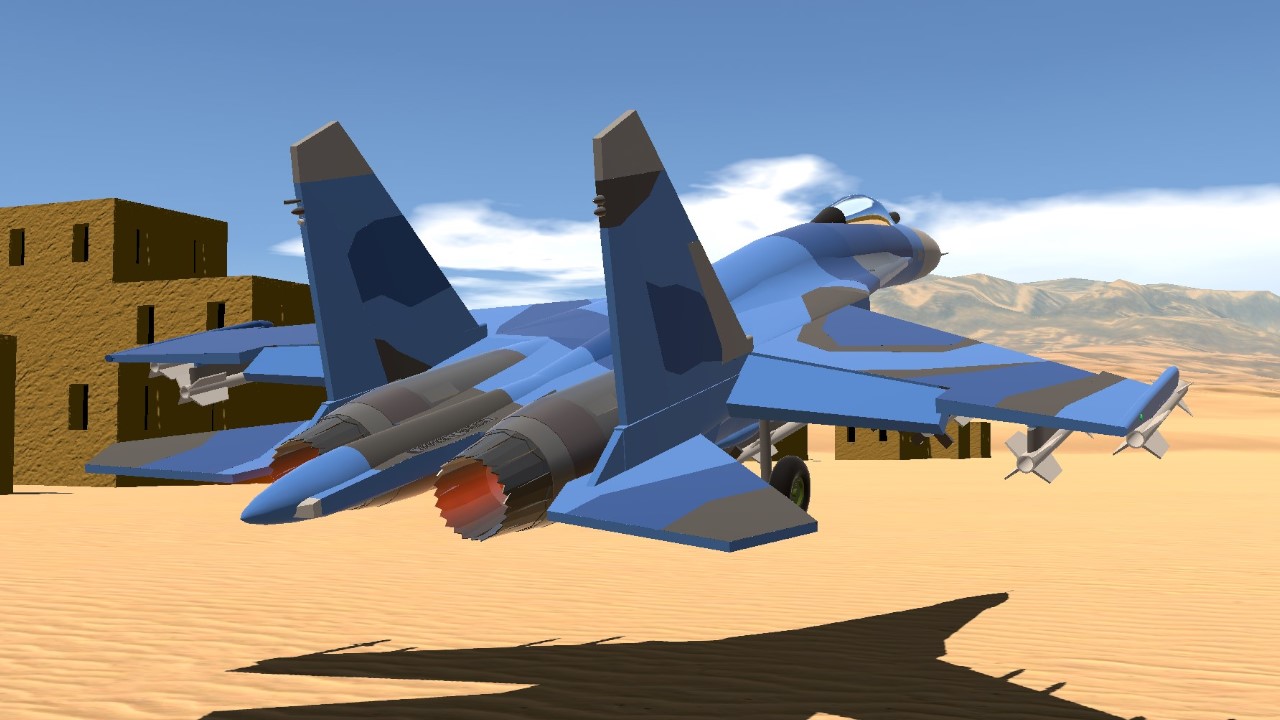
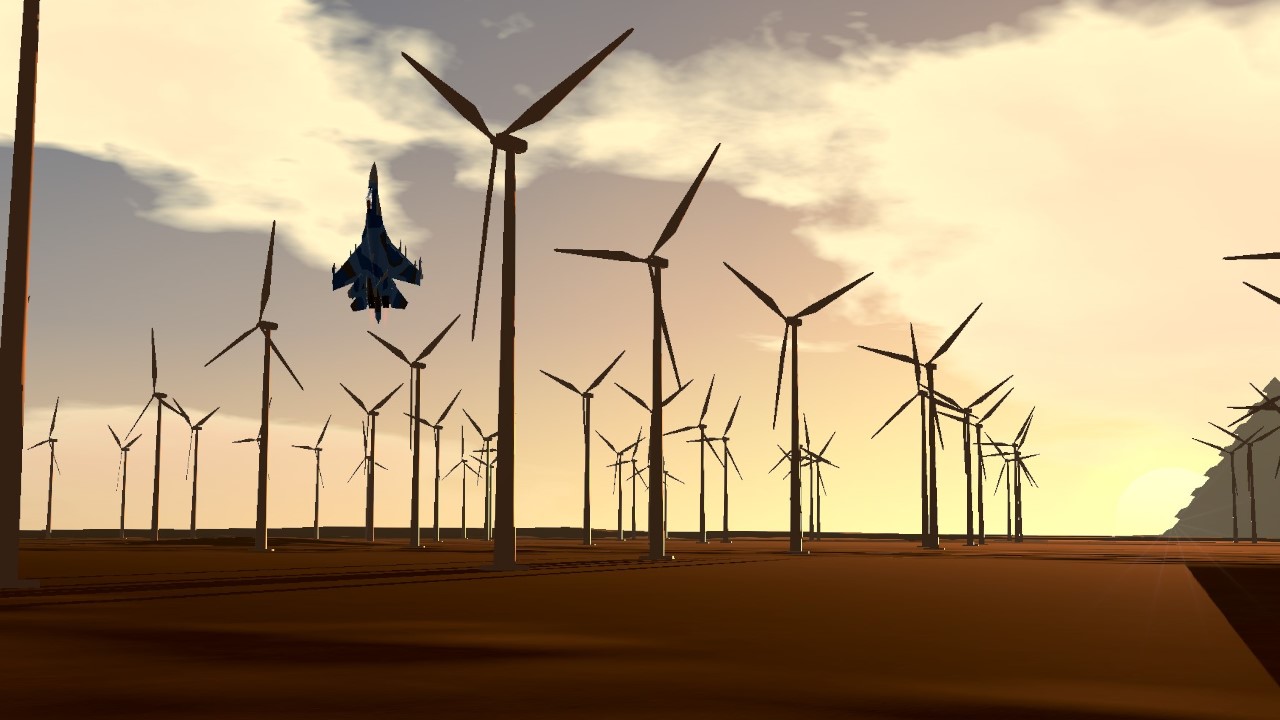
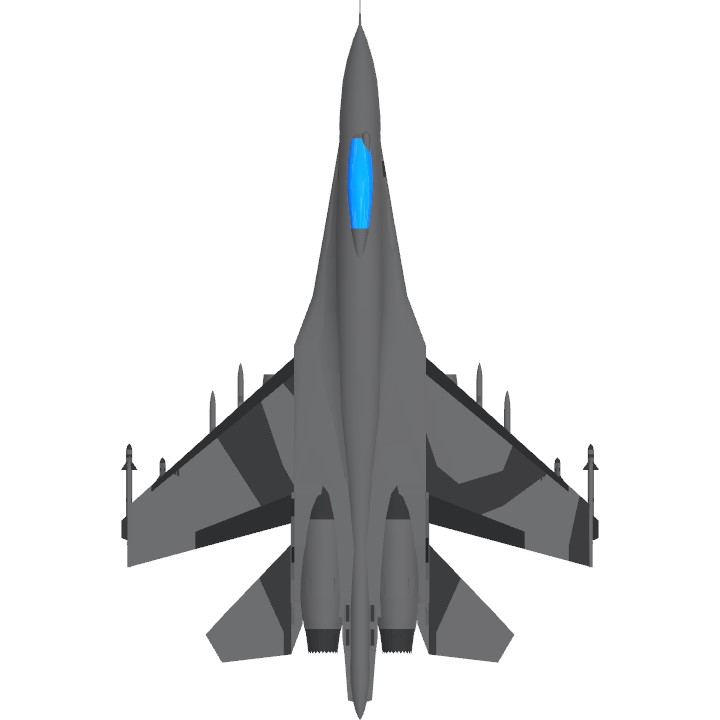
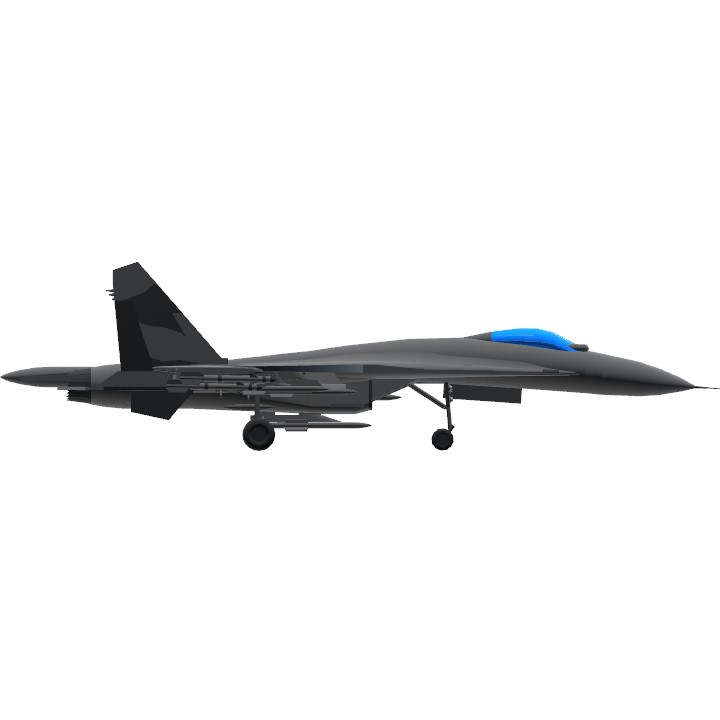
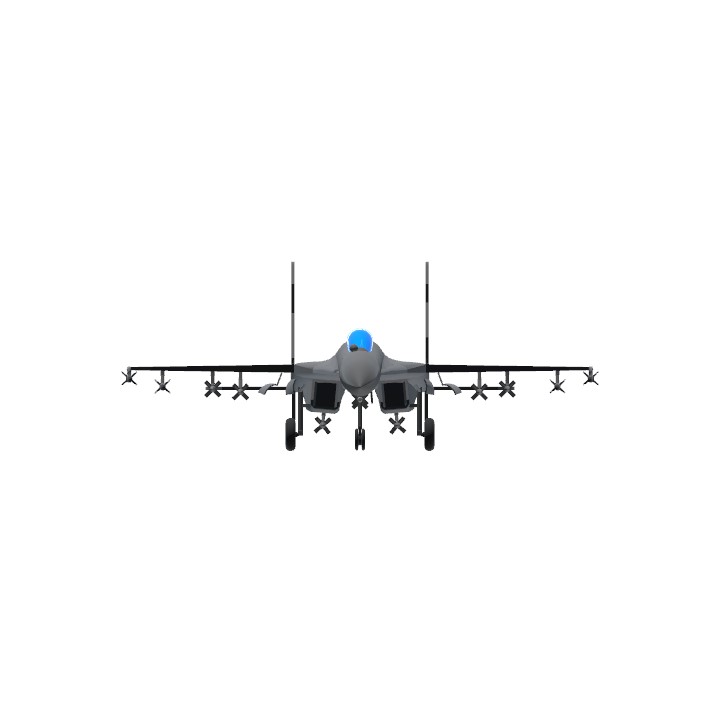
Credits:
@ReinMcdeer